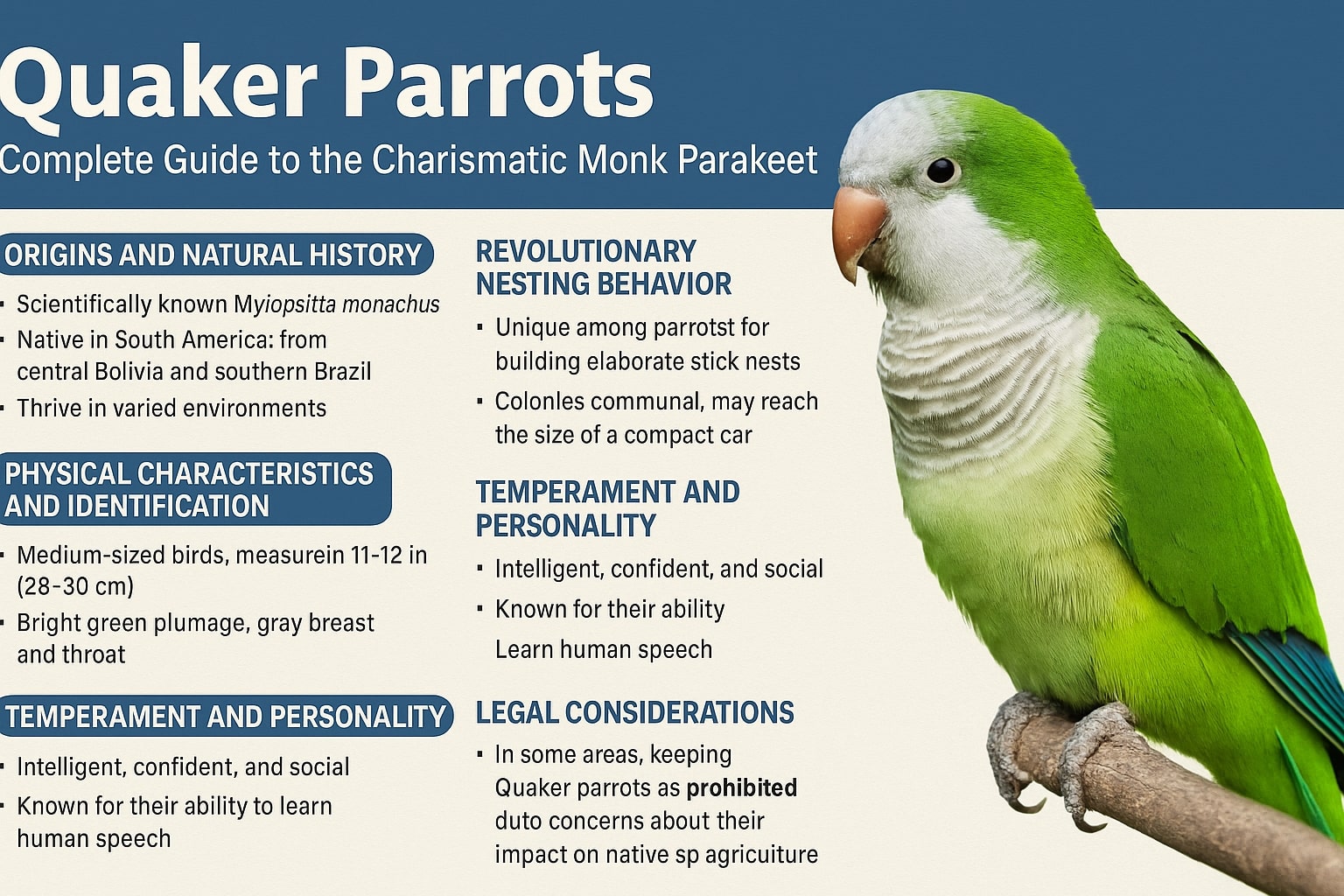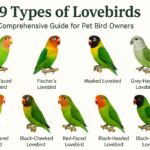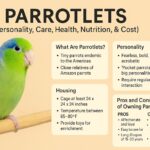Quaker parrots, scientifically known as Myiopsitta monachus, represent one of the most fascinating and adaptable members of the parrot family. These remarkable birds have captured the hearts of pet owners worldwide with their vibrant personalities, exceptional intelligence, and unique behaviors that set them apart from other parrot species.
Unlike many tropical parrots that require warm climates, Quaker parrots have demonstrated an extraordinary ability to thrive in diverse environments, from their native South American habitats to urban centers across North America and Europe.
Origins and Natural History
The Quaker parrot’s story begins in the temperate regions of South America, where these birds have evolved over millennia to become one of nature’s most successful parrot species. Native to a relatively small portion of South America, their natural range extends from central Bolivia and southern Brazil into parts of central Argentina.
In their homeland, these birds typically inhabit woodlands and dry savannas with scattered trees at elevations up to approximately 6,000 feet.
What makes Quaker parrots particularly remarkable is their natural hardiness and adaptability. Unlike most parrot species that are confined to tropical or subtropical regions, these birds have evolved to withstand temperature variations that would prove fatal to their tropical cousins. This resilience has enabled them to establish thriving populations far beyond their native range, creating a global phenomenon that continues to fascinate ornithologists and bird enthusiasts alike.
The taxonomic classification of Quaker parrots reveals interesting variations within the species. Five subspecies are recognized by the Global Biodiversity Information Facility, including monachus, calita, coloma, cotorra, and luchsi.
The nominate subspecies monachus represents the largest variety, while subspecies calita displays distinctive bluer wings and a darker grey head. Subspecies cotorra exhibits brighter green coloration on its upper parts with less yellowish tinting on the abdomen compared to calita. Some researchers consider the luchsi subspecies sufficiently distinct in morphology, behavior, and distribution to warrant elevation to separate species status.
Physical Characteristics and Identification
Quaker parrots are medium-sized birds that typically measure between 11 to 12 inches from beak to tail, with adults weighing between 4 and 5 ounces. Their compact size makes them an ideal choice for bird enthusiasts who desire the personality and intelligence of larger parrots without the space requirements and challenges associated with macaws or cockatoos.
The most distinctive feature of Quaker parrots is their striking coloration pattern. These birds display predominantly bright green plumage covering their face, back, belly, and tail feathers.
The contrast between their vibrant green bodies and their characteristic grey breast and throat creates an unmistakable appearance that makes identification relatively straightforward even for novice bird watchers. Their long, graduated tails add to their elegant silhouette and contribute to their graceful flight patterns.
The robust build of Quaker parrots reflects their hardy nature and adaptability to various environmental conditions. Their strong, curved beaks are perfectly designed for their varied diet, capable of cracking nuts and seeds while being gentle enough to manipulate delicate fruits and blossoms. Their zygodactyl feet, with two toes facing forward and two backward, provide excellent grip for climbing and manipulating food items and nesting materials.
Revolutionary Nesting Behavior
Perhaps the most extraordinary aspect of Quaker parrot biology is their unique nesting behavior, which sets them apart from every other member of the parrot family. Quaker parrots are the only parrots known to build elaborate stick nests, a behavior that has contributed significantly to their success as a species. This remarkable adaptation has enabled them to thrive in environments where natural tree cavities are scarce or unavailable.
The construction of Quaker parrot nests represents a marvel of avian engineering. These birds invest considerable time and energy creating elaborate dwellings from carefully selected twigs and branches.
Their nests feature multiple chambers, with some structures containing up to 20 individual nest chambers, and extreme cases housing more than 200 nests. The communal nature of these nesting structures creates what can only be described as Quaker communities, with flocks often building nests adjacent to each other.
The size and complexity of these nest structures can be truly impressive. Mature nest colonies can grow to the size of a compact car, with some structures measuring more than 5 feet across and weighing over a ton. These permanent structures provide year-round shelter for the colony, which may explain why Quaker parrots can survive cold winters that would be lethal to other parrot species.
The construction process involves the entire colony, including young birds and non-breeding individuals who contribute to building and maintaining the communal nests. The birds often select thorny twigs for construction, which may provide better structural integrity or offer protection from predators. Within the larger structure, individual pairs create their own chambers by fashioning floors, walls, and roofs to enclose round nest spaces connected to the outside through entrance tunnels.
Diet and Feeding Behavior
Quaker parrots demonstrate remarkable dietary flexibility, which has contributed to their success in diverse environments. In their natural habitat, these birds consume a varied diet consisting of seeds, buds, fruits, berries, nuts, and blossoms. This dietary diversity reflects their opportunistic feeding behavior and ability to adapt to seasonal variations in food availability.
Their reputation as agricultural pests stems from their willingness to feed on cultivated crops, including sunflower seeds, corn, wheat, sorghum, and rice. However, scientific confirmation of significant agricultural damage remains largely unestablished, suggesting that their impact on crops may be less severe than commonly believed.
During winter months in their introduced ranges, Quaker parrots supplement their natural diet by visiting backyard bird feeders, demonstrating their adaptability to human-modified environments.
The feeding behavior of Quaker parrots reflects their social nature and intelligence. These birds often feed in flocks, with individuals taking turns acting as sentries while others forage. This cooperative behavior enhances their survival chances and has contributed to their success in establishing populations in new territories.
Temperament and Personality
Quaker parrots possess personalities that seem disproportionately large for their medium size. These birds are naturally confident and social creatures that thrive on interaction and mental stimulation1. Their reputation as entertaining companions stems from their naturally playful and somewhat clownish behavior, often seeking to become the center of attention in their human families.
The intelligence of Quaker parrots manifests in their remarkable ability to learn human speech and their capacity for problem-solving. Many owners report that their Quaker parrots not only learn words and phrases but use them in appropriate contexts, demonstrating genuine understanding rather than mere mimicry.
This cognitive ability, combined with their social nature, makes them excellent candidates for positive reinforcement training and interactive play.
Bold and outgoing by nature, Quaker parrots tend to approach new situations with curiosity rather than fear. This confidence can be both a blessing and a challenge for owners, as these birds may attempt to dominate their environment and establish themselves as flock leaders. Proper socialization and consistent training are essential for maintaining a harmonious relationship with these strong-willed birds.
Health Considerations and Medical Care
Responsible Quaker parrot ownership requires understanding the health challenges that may affect these birds. Several viral diseases pose significant threats to Quaker parrot populations, with some conditions proving fatal if not properly managed. Pacheco’s disease represents one of the most serious health concerns, caused by a herpes virus that occurs naturally in South America.
This highly contagious condition causes more deaths among birds than any other avian disease, with an incubation period of 5 to 14 days and often results in death without apparent symptoms due to rapid liver damage.
Avian poxvirus infection represents another significant threat, being the most common and deadliest viral disease affecting Quaker parrots. All Quaker parrot species are susceptible to this condition, which typically manifests as the wet form affecting mucous membranes of the eyes, mouth, and respiratory systems. The mortality rate for infected birds is usually high, and survivors often carry permanent physical and psychological scars.
Psittacosis, also known as parrot fever or chlamydiosis, can affect Quaker parrots of any age, though young birds are more susceptible due to their immature immune systems. This condition may cause respiratory disorders, including sneezing, nasal discharge, and pneumonia, as well as lime-green watery droppings indicating kidney and liver dysfunction.
Prevention remains the most effective approach to maintaining Quaker parrot health. Proper quarantine procedures for new birds, maintaining clean living environments, and regular veterinary check-ups can significantly reduce disease risks. Owners should establish relationships with avian veterinarians experienced in parrot care and maintain awareness of symptoms that warrant immediate medical attention.
Legal Considerations and Regulations
Prospective Quaker parrot owners must navigate complex legal landscapes that vary significantly by location. In some parts of the United States, keeping Quaker parrots as pets is prohibited due to concerns about their potential impact on native ecosystems and agriculture. These regulations reflect legitimate concerns about invasive species, as feral Quaker parrot populations have successfully established themselves in many urban areas worldwide.
The introduction of Quaker parrots to North America occurred primarily during the 1960s through the release or escape of pet birds. Since then, their populations have grown and spread to various regions, particularly in warmer climates. While some jurisdictions welcome these colorful additions to their urban wildlife, others view them as potential threats requiring active management.
Before acquiring a Quaker parrot, potential owners must research local and state regulations to ensure compliance with applicable laws. Some areas may require special permits or prohibit ownership entirely, while others may have specific requirements for housing and care. Responsible ownership includes understanding these legal obligations and maintaining proper documentation when required.
Conclusion
Quaker parrots represent a unique success story in the avian world, combining remarkable adaptability with engaging personalities that have endeared them to bird enthusiasts worldwide. Their extraordinary nesting behavior, dietary flexibility, and temperature tolerance have enabled them to thrive in environments far from their South American origins.
As pets, they offer the intelligence and companionship of larger parrots in a more manageable size, making them suitable for dedicated bird enthusiasts willing to provide proper care and attention.
The responsibility of Quaker parrot ownership extends beyond providing daily care to include understanding legal requirements, health management, and the long-term commitment these birds require.
lifespans potentially exceeding 30 years, Quaker parrots represent a significant commitment that rewards dedicated owners with decades of companionship and entertainment. Their success as both wild and captive birds demonstrates their remarkable resilience and adaptability, qualities that continue to fascinate researchers and delight pet owners around the globe.
For those considering adding a Quaker parrot to their family, careful research and preparation are essential. Understanding their unique needs, personality traits, and legal status in your area will help ensure a successful relationship with these remarkable birds. With proper care, Quaker parrots can provide years of joy, companionship, and endless entertainment for those willing to appreciate their distinctive charm and intelligence.
- Parrotlets (Personality, Care, Health, Nutrition, & Cost) - June 20, 2025
- Caique (Personality, Care, Health, & Nutrition) - June 20, 2025
- The Complete Guide to Golden Retrievers - June 9, 2025















